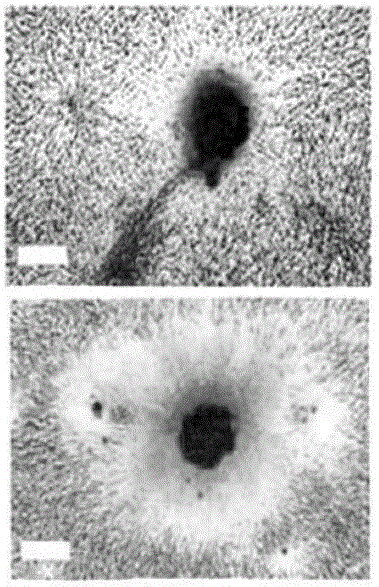Stem cell recovery method of cryopreserved umbilical cord blood with high recovery rate
A cord blood stem cell, high resuscitation rate technology, applied to blood/immune system cells, animal cells, vertebrate cells, etc., can solve the problems of reducing the resuscitation rate of cryopreserved cells, penetration damage of protective agents, cytotoxic damage, etc. Achieve the effect of reducing cytotoxic damage, reducing mechanical damage, and increasing contact area
- Summary
- Abstract
- Description
- Claims
- Application Information
AI Technical Summary
Problems solved by technology
Method used
Image
Examples
Embodiment 1
[0034] Such as figure 1 As shown, a method for resuscitating cryopreserved cord blood stem cells with a high recovery rate comprises the following steps:
[0035] Step 1: Take out the cryopreservation solution from liquid nitrogen, put it into LNG and heat it up for 1 minute;
[0036] Step 2: Take out the cryopreserved liquid from LNG, put it into an ice bath under vacuum, and rapidly cool down to 3.2°C at an average heating rate of 560°C / min;
[0037] Step 3: Pour the cryopreservation solution into 0.9% saline, maintain the temperature at 3.2°C, add 17% human serum albumin without fibrinogen under the condition of infrasonic oscillation (frequency 8Hz), 3 % gamma globulin, 17% fibrinogen-free human serum albumin, 3% gamma globulin, 0.8% monosaccharides, 0.21% cell growth factors, 0.8% non-essential amino acids, 0.08 % R-glutamine, 0.03% β-mercaptoethanol, adjust the pH of the system to 7.6, add 1.5% hydroxyethylpiperazine ethanesulfonic acid, and continue to oscillate under...
Embodiment 2
[0049] A method for resuscitating cryopreserved umbilical cord blood stem cells with a high recovery rate, comprising the following steps:
[0050] Step 1: Take out the cryopreservation solution from liquid nitrogen, put it into LNG and heat it up for 1 minute;
[0051] Step 2: Take out the cryopreserved liquid from LNG, put it into an ice bath under vacuum, and rapidly cool down to 3.9°C at an average heating rate of 560°C / min;
[0052] Step 3: Pour the cryopreservation solution into 0.9% saline, maintain the temperature at 3.9°C, add 17% human serum albumin without fibrinogen under the condition of infrasonic (frequency 13Hz) oscillation, 3 % γ-globulin, 1% monosaccharide, 0.23% cell growth factor, 1.2% non-essential amino acid, 0.12% R-glutamine, 0.04% β-mercaptoethanol, adjust the pH of the system to 7.9 , add 1.5% hydroxyethylpiperazine ethanesulfonic acid, continue to shake under infrasonic conditions for 45s;
[0053] Step 4: Centrifuge the diluted cryopreservation so...
Embodiment 3
[0064] A method for resuscitating cryopreserved umbilical cord blood stem cells with a high recovery rate, comprising the following steps:
[0065] Step 1: Take out the cryopreservation solution from liquid nitrogen, put it into LNG and heat it up for 1 minute;
[0066] Step 2: Take out the cryopreserved liquid from LNG, put it into an ice bath under vacuum, and rapidly cool down to 3.6°C at an average heating rate of 560°C / min;
[0067] Step 3: Pour the cryopreservation solution into 0.9% saline, maintain the temperature at 3.6°C, add 17% human serum albumin without fibrinogen under the condition of infrasonic (frequency 10Hz) oscillation, 3 % γ-globulin, 0.9% monosaccharide, 0.22% cell growth factor, 1.1% non-essential amino acid, 0.1% R-glutamine, 0.032% β-mercaptoethanol, adjust the pH of the system to 7.7 , add 1.5% hydroxyethylpiperazine ethylsulfuric acid, continue to shake under infrasonic conditions for 40s;
[0068] Step 4: Centrifuge the diluted cryopreservation s...
PUM
 Login to view more
Login to view more Abstract
Description
Claims
Application Information
 Login to view more
Login to view more - R&D Engineer
- R&D Manager
- IP Professional
- Industry Leading Data Capabilities
- Powerful AI technology
- Patent DNA Extraction
Browse by: Latest US Patents, China's latest patents, Technical Efficacy Thesaurus, Application Domain, Technology Topic.
© 2024 PatSnap. All rights reserved.Legal|Privacy policy|Modern Slavery Act Transparency Statement|Sitemap

